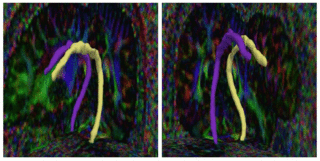Difference between revisions of "2009 Winter Project Weekga"
Vandymohan (talk | contribs) (2009 Winter Project week : Tubular surface extraction framework for Cingulum Bundle from DWI Imagery) |
Vandymohan (talk | contribs) |
||
| (One intermediate revision by the same user not shown) | |||
| Line 1: | Line 1: | ||
{| | {| | ||
|[[Image:NAMIC-SLC.jpg|thumb|320px|Return to [[2009_Winter_Project_Week|Project Week Main Page]] ]] | |[[Image:NAMIC-SLC.jpg|thumb|320px|Return to [[2009_Winter_Project_Week|Project Week Main Page]] ]] | ||
| − | |[[Image: | + | |[[Image:Tub-results-Img1.gif|thumb|320px]] |
| − | |||
|} | |} | ||
Latest revision as of 21:26, 24 November 2008
Home < 2009 Winter Project Weekga Return to Project Week Main Page |
Key Investigators
- Allen Tannenbaum, Vandana Mohan, Georgia Tech
- Ganesh Sundaramoorthi, UCLA
- Marek Kubicki, BWH
Objective
- To integrate the new tubular volumetric segmentation framework into GATech's DWI processing pipeline in Slicer and apply it to DWI population brain data.
- To adapt the algorithm to handle moving end points towards segmenting blood vessels from CT cardiac data.
Approach, Plan
After testing the current MATLAB implementation of the framework, we will be integrating it into volumetric segmentation step of the DWI processing pipeline and test it on the DWI population data towards extracting the tubular surface representations to use for subsequent population analysis. We will also be testing the moving end points implementation in MATLAB on cardiac data.
Progress
The fixed end points implementation in MATLAB has been tested successfully on brain DWI data (See Mohan et al below). Upon integration into Slicer, we can run the algorithm to extract the surface representations for the population of DWI brain data and test its effectiveness in population analysis. We are also currently testing the MATLAB implementation of the moving end points version of the algorithm for vessel data, with possible extension to brain DWI data.
References
- V. Mohan, G. Sundaramoorthi, J. Melonakos, M. Niethammer, M. Kubicki, and A. Tannenbaum. Tubular Surface Evolution for Segmentation of Tubular Structures with Applications to the Cingulum Bundle From DW-MRI. In Proceedings of MICCAI Workshop on Mathematical Foundations of Computational Anatomy, 2008.
- Sundaramoorthi, G. Yezzi, A. Mennucci, A. Sobolev Active Contours. Springer-Verlag Lectures in Computer Science. 2005, NUMB 3752, pages 109-120
